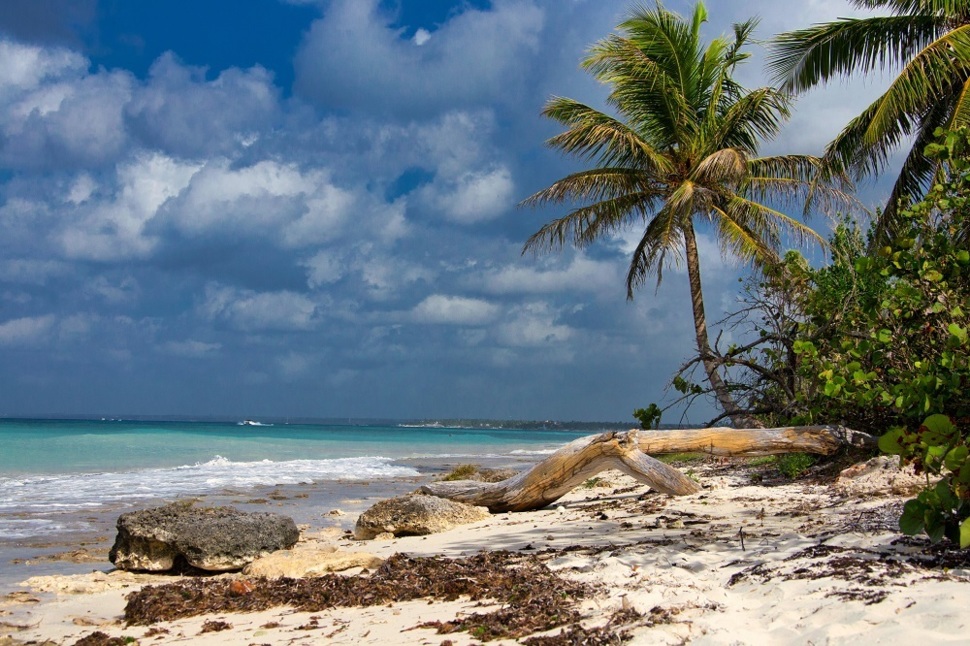10 reasons to visit the Dominican Republic
Dec 06, 2023

Bienvenidos a la República Dominicana, amigos!
Welcome to the Dominican Republic, friends!
This small but very attractive state is located in the eastern part of the island of Haiti. Until the end of the 15th century, the territory of the modern Dominican Republic was inhabited by Indian tribes, and in 1492 their land was discovered by Christopher Columbus.
Over the next three centuries, the island was claimed alternately by Spain, Great Britain and France. In 1844, residents of the eastern part declared the independence of the Dominican Republic, although even after that local political life could hardly be called calm. In 1869, the then government even tried to annex the Dominican Republic to the United States, but the American Senate was against it. Several coups d'etat, invasions by other states and economic crises later, the political situation on the island calmed down.
Now the Dominican Republic is one of the most attractive places for tourists. A real Paradise on earth - by the way, this is how the island was described by Christopher Columbus. And now we will name as many as 10 reasons why everyone must visit the Dominican Republic!
Ideal climate
A country where summer lasts all year round - that’s what the Dominican Republic can be called. A tropical climate always reigns here. The average annual temperature is the most comfortable - 25 ° C. At higher elevations it is slightly lower - about 18 ° C, and at sea level it is higher - 28 ° C. Thanks to the sea winds, both children and adults can easily tolerate this temperature. Snowfall in this country can only be seen on rare occasions at the top of Mount Pico Duarte.
It is pleasant to relax in the Dominican Republic at any time of the year; the weather practically does not depend on the season. The exception is the rainy season, but even this is as mild as possible and lasts from May to October. Precipitation most often falls at night and does not affect rest in any way.
Clean and safe beaches
The southern coast of the island is washed by the Caribbean Sea, and the northern and eastern coast is washed by the Atlantic Ocean. Only here you can see several dozen shades of blue water that washes the soft white sand. Its temperature all year round ranges from +27 to 29° C. Almost 1,500 kilometers of coastline allow every tourist to fully enjoy their holiday.
Another important advantage of the Dominican beaches is that they are completely safe, as they are surrounded by a natural reef. It protects all swimmers from the inhabitants of the ocean. In these waters you won’t see any sharks or jellyfish; at most you might catch a sea urchin near the underwater rocks. Therefore, both children and adults can safely dive into the water.

Developed tourist infrastructure
Tourism is one of the most important areas developed in the Dominican Republic. Several million tourists come here every year. The country is doing everything to ensure that guests of the island feel as comfortable as possible, starting from the moment of arrival. There are several international airports with direct flights from Europe and North, Central and South America.
Foreigners can choose to stay in simple beach houses or hotels in cities, as well as world-class hotels. The most famous resort area is Punta Cana. The tourist area is 30 km of coastline with beautiful beaches, next to which there are upscale hotels. It has everything you need for a good rest - restaurants, spas, swimming pools and gyms, as well as attentive staff who are ready to fulfill any desire of the guests.
Unique nature
The nature of the Dominican Republic is amazingly beautiful. Almost a third of the country's territory is occupied by nature reserves, carefully protected by the state. The most interesting are Armando Bermudez, Del Este and Los Haitises. In a relatively small area there are completely different landscapes and zones.
A significant part of the country is occupied by four mountain ranges. They are also home to the highest point of the Caribbean Sea - Pico Duarte (3098 meters above sea level), which is especially loved by climbers. And a small settlement in the central part of the country of Jarabacoa is known as the “city of waterfalls.” There are a huge number of them here, the most popular: El Salto Jimenoa, El Salto de Bayagate, Balneario de la Confluencia. Near another city called Monte Cristi are the salt lakes of Lago Enrichio, interesting for their unusual appearance.
It is not only the territory of the island of Haiti that deserves attention. The atmospheric caves are located in the Haitises National Park on the Samana Peninsula. And in the Banco de la Plata Marine Reserve you can watch humpback whales breeding between mid-January and mid-March. In addition, large sea turtles lay their eggs on the beaches of the Siete Hermanos island group from November to February.

Rich cultural heritage
The Spaniards, who sailed to the island in past centuries, brought with them Christianity, language, as well as European traditions. They mixed with the customs of the local inhabitants - European Tainos and African peoples. Such a complex interweaving of myths, religions and worldviews has become the basis of the culture of the modern Dominican Republic.
Its important part is music. It was here that a special style, including both melody and dance, was born in the 19th century - merengue. It is characterized by a fast tempo created by traditional Antillean musical instruments. It is worth noting bachata, a passionate dance that also appeared for the first time in the Dominican Republic. Close contact with a partner accompanied by romantic music will make the heart of any tourist flutter.
The country's rich cultural heritage can be easily traced through its most important landmarks. Thus, you cannot ignore the Columbus Lighthouse, which is located in the capital of the country - Santo Domingo. The structure, 33 meters high and 310 meters long, looks like a multi-stage Indian pyramid from the side, and has the shape of a cross on top. The supposed remains of Christopher Columbus are kept inside.
Another important place that will definitely interest visitors to the island is Altos de Chavon or the city of artists. This is a replica of a medieval village, recreated by Italian designer Roberto Copa. Today, modern restaurants, shops and craft workshops are hidden in the limestone houses that fill the narrow streets. There is even a “Greek” amphitheater, inaugurated in 1982 with a concert by Frank Sinatra and Carlos Santana. And in the Church of St. Stanislaus in 2006, a member of the Spanish royal family got married.
Carnivals
Among other things, the Spaniards brought to the Dominican Republic a love of bright and lavish celebrations. The most important carnival traditionally takes place before Lent at the end of winter and lasts throughout February. During this period, every weekend local residents dress up in colorful costumes and take to the streets of the cities. Theatrical performances, marches, music and dance shows last all night!
The images of the participants are striking in their diversity, because Dominicans prepare for the holiday all year long - here you can meet movie heroes, historical figures, and characters from local legends. The best are selected and awarded by a special jury. Carnivals also occur throughout the rest of the year, usually around important holidays, but the one in February is the most memorable.

Fresh fruits and exotic cuisine
How many ways to use bananas do you know? Definitely less than what is used in the Dominican Republic. It is fried, stewed, added to sweet and salty dishes, in a word, used to the maximum. Thanks to the tropical climate in the Dominican Republic, you can enjoy fresh exotic fruits, vegetables and root vegetables all year round. Try local mango, lychee, pitahaya, passion fruit, longan, guanabana to find out what summer tastes like.
And don’t miss the opportunity to appreciate another important product - cocoa. The Dominican Republic is one of its main producers in the world. Local residents make an unusual delicacy from cocoa beans - chocolate balls. To do this, sugar, vanilla, cinnamon and even pepper are mixed with coarsely ground cocoa mass and cooled. Tourists can learn more about the culture of growing and consuming these popular beans on special excursions to the plantations of local farmers.
And, of course, pay attention to Dominican coffee. Local varieties have an original taste. It combines a subtle fruity taste with sourness, a good, strong infusion and a soft, delicate aroma. Residents of the Dominican Republic drink this drink very strong and with a lot of sugar.
Availability of sports
As strange as it may sound, the Dominican Republic is a great place to play golf. There are more than 30 excellent courses for this sport in the country. Thousands of tourists come here every year just for training and various tournaments.
A separate category is water entertainment. Experienced divers will appreciate the rich underwater world of the Caribbean. The extended system of underwater caves with Padre Nuestro stalactites is especially picturesque. And surfers will be interested in beaches with raging waves in the north of the country. The city of Cabarete has all the necessary infrastructure, schools operate and equipment rental is available.
In addition, you can always visit the rope park, take a horseback ride through local nature reserves, see the surrounding landscapes while descending under a paragliding canopy or climbing mountain ranges.
Local cigars
Even if you yourself are absolutely indifferent to cigarettes, it’s worth taking a closer look at local tobacco. The Dominican Republic is the world's leading exporter of high-quality cigars. Their production amounts to millions of pieces per year.
The island's natives have been growing and consuming tobacco leaves since ancient times. Currently, three types of tobacco are found in the Dominican Republic. To achieve an unusual taste and aroma, it is sometimes soaked in vanilla, cognac, chocolate or fruit juice. Local residents still produce cigars by hand, following ancient technology. They will be an excellent souvenir and reminder of the days spent on the island.
Night life
Dominicans know how to have fun not only during the day, but also at night. Life is most intense in Santo Domingo, the capital of the country. Dance clubs, bars and restaurants open until the morning invite both local residents and tourists. It is not without reason that another symbol of the republic is Dominican rum. This drink is respected by many here. You can buy the most popular varieties with a short aging period in regular supermarkets. And more valuable types should be purchased in souvenir shops aimed at tourists.
The Dominicans also took care of gambling fans. Many upscale hotels have entire casinos. Guests are offered various types of poker, blackjack, roulette tables and slot machines for every taste.
Choose the all-inclusive option and enjoy the game while sipping on complimentary cocktails, sampling local cuisine and relaxing in luxurious accommodations right on the edge of the azure sea. But you shouldn’t get carried away, because the chance of winning in such casinos is very small, and there are too many interesting things around to miss the opportunity to try all the entertainment available in the Dominican Republic.
We send only top, fresh and useful info.
Subscribe and be the first to know!


 USD - $
USD - $  EUR - €
EUR - € 











